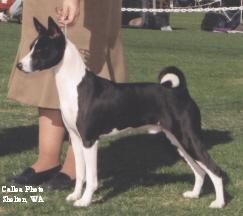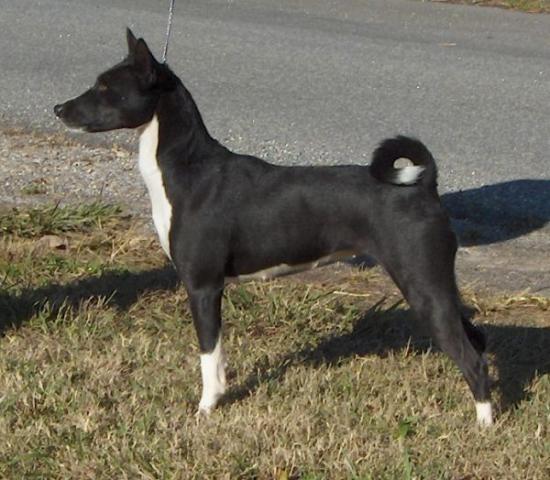Thank you so much for your suggestions, the first test was at a 5.7 and I am awaiting the results of a second test. The initial blood test also revealed Diabetes Insipidus but I feel there is more to it than that and I see many of the symptoms of hyperthyroidism which i've read is usually results from medication for hypo and I had not given any such meds so it's a mystery how it was contracted. And we did lose her half brother in January which would explain added stress.
Don
Coat Color Inheritance in basenji
-
I am beginning to be wrong.I'm going to sleep until tomorrow. (11 _55 PM)
-
from K locus we got:
Kk (and again Kk) - 1
kk (and again kk) - 2from A locus we got:
YY - a
Yy (and again Yy) - b
yy - c1 + a = 1a (Kk YY)
1 + b = 1b (Kk Yy)
1 + c = 1c (Kk yy)
2 + a = 2a (kk YY)
2 + b = 2b (kk Yy)
2 + c = 2c (kk yy) -
from K locus we got:
Kk (and again Kk) - 1
kk (and again kk) - 2from A locus we got:
YY - a
Yy (and again Yy) - b
yy - c1 + a = 1a (Kk YY)
1 + b = 1b (Kk Yy)
1 + c = 1c (Kk yy)
2 + a = 2a (kk YY)
2 + b = 2b (kk Yy)
2 + c = 2c (kk yy)Oh ook i think i get it now, thx for the help in clearifying it. so would "A" always be YY, "b" always be Yy and "C" always be yy? or is that just for this example?
-
Just for that example.
-
oh. so how do you know what to use then.

-
It depends on the alleles of the dog. The litter that I co-bred and have been posting puppy pictures of the parents are KkYy and KkYY. If you do the two punnet square way instead of the 16 punnet square way you would get.
At the K locus
….......K........k
K........KK.......Kk
k........Kk.......kkAt the A locus
.............Y.............y
Y..........YY...........Yy
Y..........YY...........YySo we get
from K locus we got:
KK - 1
Kk (we get this twice) - 2
kk - 3from A locus we got:
YY (we get this twice) - a
Yy (we get this twice) - b1 + a = 1a (KK YY)
1 + b = 1b (KK Yy)
2 + a = 2a (Kk YY)
2 + b = 2b (Kk Yy)
3 + a = 3a (kk YY)
3 + b = 3b (kk Yy) -
hmmm. I guess i dont really get this part. How do you do a 16 punnet square? Maybe that will be easier for me. (maybe not lol)
ill try to examine them some more and see if i cant get it down.
-
I will see if I can get a graphic for a 16 square punnet tomorrow.
-
Ok thank you
 id like to see that
id like to see that -
It depends on the alleles of the dog. The litter that I co-bred and have been posting puppy pictures of the parents are KkYy and KkYY.
What is KkYy? is this a Black basenji with a tri gene? and KkYY. is this a red Basenji with a black gene?
these are, ironically, the only two that i didnt understand what they would be as dogs.
-
KkYy - a black dog that can produce blacks, reds, and tris
KkYY - a black dog that can only produce blacks and reds -
Cole - has a black and white dam and a tri dad. Based on his mom's litters we believe she is KkYY which makes him KkYy. He has to carry tri since his dad is tri.
TC - has a black and white sire and red and white dam. Based on pedigree and breedings, we believe she is KkYY.


-
O ok this makes sense. Is there a way you could help me determine what my girl is? Ill link the colors of the parents and maybe you can help me determine what she is.
http://prairielandbasenjis.webs.com/colorinheritance.htm
I put the link on my website. With a couple questions for you on there. Once i figure everthing out i wont be having it on there anymore. If you could try to determine what she is i would greatly appreciate it! But also if you could remember how you did it and explain it to me so i can understand. Thank you!
-
Cole - has a black and white dam and a tri dad. Based on his mom's litters we believe she is KkYY which makes him KkYy. He has to carry tri since his dad is tri.
TC - has a black and white sire and red and white dam. Based on pedigree and breedings, we believe she is KkYY.
What did this breeding result in with a litter, Color wise? and if cole had been a kkYy (red male) what would/could they have produced then?
-
O ok this makes sense. Is there a way you could help me determine what my girl is? Ill link the colors of the parents and maybe you can help me determine what she is.
http://prairielandbasenjis.webs.com/colorinheritance.htm
I put the link on my website. With a couple questions for you on there. Once i figure everthing out i wont be having it on there anymore. If you could try to determine what she is i would greatly appreciate it! But also if you could remember how you did it and explain it to me so i can understand. Thank you!
Well since she is red she is definately kk and has at least one Y. There is about a 50% chance that she is a tri carrier. So she is either kkYy or kkYY
-
What did this breeding result in with a litter, Color wise? and if cole had been a kkYy (red male) what would/could they have produced then?
This resulted in 3 black and whites and 1 red and white. Statistically bred a tri factored red she should produce 50% reds and 50% blacks. Her first litter was sired by a tri factored red and she had 2 reds and 3 blacks.
-
ok awesome! I did it right! That is what I was thinking. but i wasnt sure which one. so in theory, i wouldnt know unless i bred her then…with a tri factored male...because breeding to a tri wouldnt prove anything...would it?
Ok well thank you. I was really curious. Now i DO know how to do gentics! Thanks to you and the help of a few other people. I appreciate it
-
Breeding to a tri would give better odds of producing tris if she is tri factored, 50% reds, 50% tris. A tri factored red would only give 25% chance of tris
-
oh. for some reason I thought …hmm that makes alot more sense. lol ya idk why but i thought if you bred to a tri it would only mean that the tri is the one giving the genes, not the tri factored so i thought you wouldnt be able to tell. but you putting it like that makes alot more sense
 I understand now thank you
I understand now thank you -
Ya know, reading coat color genetics has always made me happy my first breed is Rottweilers.:)
Yes, I understand coat color genetic basics, but it makes my head hurt.